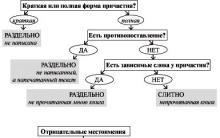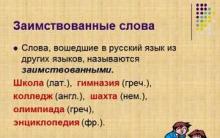Russian language lesson in 3rd grade (UMK "Perspective")
Teacher: Shurinova O.M.
Class: 3 G
Subject:“Parsing a noun as a part of speech”
Lesson type: lesson in discovering new knowledge
Goals:
To update knowledge about the concepts of “noun”, “signs of a noun”.
Introduce an algorithm for parsing a noun as a part of speech.
Cognitive skills:
Reveal the meaning of the concepts “noun”, “signs of a noun” and use them in an active dictionary;
Distinguish between constant and variable features of a noun and justify your opinion.
Regulatory skills:
Carry out a learning activity using an algorithm.
Communication skills:
Take into account the partner’s opinion when making a common decision within the educational dialogue.
Subject Skills:
Talk about the constant and variable features of a noun;
Explain the algorithm for parsing a noun as a part of speech;
Identify nouns in a sentence;
Parse a noun as a part of speech using an algorithm.
Equipment: textbook “Russian language” by L.F. Klimanova, T.V. Babushkina, presentation for the lesson in PowerPoint 2013 format, help cards
DURING THE CLASSES
| STAGE 1 Self-determination for activity |
||
| Activity goals | Situational task | Planned result |
| Motivate students to study the topic. | Let's tell you about ourselves (SLIDE1): We are intelligent! We are friendly! We are attentive! We are diligent! We're in third grade, We can do this! Words on the board (SLIDE2): eyes, coals, nose, carrot, bucket, head, broom. What task do I want to offer you? What can you tell us about these words? Children's answers. Make up a story about each word (group work). Examination. What did you notice? Everyone has their own order. Do you think order is necessary? Children's answers. Formulate the lesson topic and goals. (SLIDE3) | Personal skills: show interest in studying the topic Regulatory skills: formulate the topic of the lesson set a goal Communication skills: formulate understandable statements within educational dialogue, using terms |
| STAGE 2 Educational and cognitive activities |
||
| Purpose of activity | Training assignments | Planned result |
| Goals: Introduce an algorithm for parsing a noun as a part of speech. | We will now turn to the information desk. What information will be important? Information desk Scheme. Consider the diagram. What can you tell me? (SLIDE 4) Did we get the information we needed? How will the diagram help us learn to parse a noun? What signs are permanent (non-permanent)? | Subject Skills: Regulatory skills: Carry out educational activities in accordance with the plan; Communication skills: Interact constructively with a partner within the educational dialogue; |
| Learn: Identify nouns in a sentence; Parse a noun as a part of speech using an algorithm; Carry out a learning activity using an algorithm | Let's look at how to write analysis in a notebook (SLIDE5): Anya and Vanya wrote down the sentence and analyzed it: We stopped near the school. (near) school-noun, initial form-school, vernacular, inanimate, female form, singular, R.p. What do we need to pay attention to when parsing? (SLIDE 6) Work by zones. Now let’s try to parse the noun ourselves. Anyone who wants to do an analysis on their own and then test themselves will work in the “achievements” zone. Those who need my help will work in the “doubt” zone. Area of "doubt": (instead of) nose- (on) the head- (with) a broom- "Achievements" zone: p.42 exercise 75 followed by self-test. (from) window-noun, Nf.-window, adjective, inanimate, s.r., singular, R.p. street-n., N.f.-street, nar., inanimate, zh.r., singular, V.p. paints-noun, N.f.-paint, adjective, inanimate, female form, plural, etc. Self-test: What mistakes did you make? Who remembers the word parsing algorithm? Is order important? | Subject Skills: Parse a noun as a part of speech. Regulatory skills: Correlate the set goal and the obtained result of the activity. Communication skills: Formulate understandable statements within the educational dialogue using terms; Take into account the partner’s opinion when making a common decision within the educational dialogue; Use language adequately to present results. |
| Learn: Identify nouns in a sentence; Parse a noun as a part of speech using an algorithm; Carry out a learning activity using an algorithm | Anya and Vanya completed their homework. Let's check if the Lions did the job. Game "The most attentive"(group work) Check whether the nouns are parsed correctly. Correct the mistakes. On pine we saw a motley woodpecker. I wanted to find him nest. (on) pine-n., N.f.-pine, proper., inanimate., zh.r., singular, d.p. woodpecker-n., N. f.-woodpeckers, nav., soul., m.r., singular, R.p. nest- noun, N.f.-nest, vernacular, inanimate, s.r., I.p. Which noun was parsed correctly? What advice would you give to the guys? | Subject Skills: Parse a noun as a part of speech. Regulatory skills: Become familiar with different ways to complete a task Communication skills: Formulate understandable statements within the educational dialogue using terms |
| Learn: Explain the algorithm for parsing a noun as a part of speech; | Drawing up an algorithm “Parsing a noun” (group work) Examination. (SLIDE 7) | Subject Skills: Know the noun parsing algorithm Regulatory skills: Carry out self-checking and mutual checking of the educational task; Communication skills: Interact constructively with a partner within the educational dialogue. |
| Stage 3 Reflective activity |
||
| Purpose of activity | Self-analysis and self-esteem student | Planned result |
| Learn: correlate the result obtained with the goal; evaluate the result of educational activities. | Self-analysis (SLIDE 8) "Complete the sentences": 1. It is important for me to learn to parse a noun as a part of speech, because... (SLIDE 9) 2. To make out a noun, you need... (SLIDE 10) Self-esteem "Finish the sentence": I... (very, not very) pleased with the result of the work I did... (on my own, with the help of a classmate, teacher). | Personal skills: evaluate the result own activities. Regulatory skills: correlate the set goal and the obtained result of the activity. |
Noun parsing plan
| I | Part of speech, general grammatical meaning and question. | ||
| II | Initial form. Morphological characteristics: | ||
| A | Constant morphological characteristics: | ||
| 1 | proper or common noun; | ||
| 2 | animate or inanimate; | ||
| 3 | genus; | ||
| 4 | declination; | ||
| 5 | number (if the word has only one form - singular or plural). | ||
| B | Variable morphological characteristics: | ||
| 1 | number (if the word changes by numbers); | ||
| 2 | case | ||
| III | Role in sentence(which part of the sentence is the noun in this sentence). | ||
You can download separately the memo “Plan for the morphological analysis of nouns” in our VK group in the album “Russian language in tables and diagrams”: https://vk.com/izdat_licey
Examples of parsing nouns
On the mail train traveling from St. Petersburg to Moscow, a young lieutenant Klimov was riding in the smoking section(Chekhov).
(IN) train
- what?
- N. f. - train.
A) Constant features: common noun, inanimate, masculine, 2nd declension.
(walking) (from) St. Petersburg
- Noun; denotes an object; answers the question Of what?
- N. f. - Petersburg.
A) Constant signs: proper, inanimate, masculine, 2nd declension, does not change in numbers - has only the singular form.
B) Inconstant signs: used in the genitive case. - In a sentence, it plays the role of an adverbial adverbial place.
(walking) (in) Moscow
- Noun; denotes an object; answers the question into what?
- N. f. - Moscow.
A) Constant signs: proper, inanimate, feminine, 1st declension, does not change in numbers - has only the singular form.
B) Inconstant signs: used in the accusative case. - In a sentence, it plays the role of an adverbial adverbial place.
(went) to department
- Noun; denotes an object; answers the question what?
- N. f. - department.
A) Constant features: common noun, inanimate, neuter, noun in -i: 2nd declension, but in the prepositional case ending -i, like nouns of the 3rd declension.
B) Inconstant signs: used in the singular form, prepositional case. - In a sentence, it plays the role of an adverbial adverbial place.
(in the department) (for) smokers
- Noun; denotes an object; answers the question for whom?
- N. f. - smoking.
A) Constant features: common noun, animate, this noun is a substantivized participle, therefore it changes according to gender ( smoking, smoking) and is inflected as a full participle.
B) Inconstant features: used in the plural form, genitive case; there is no gender, like the full participles in the plural. - In a sentence it plays the role of an inconsistent definition.
(drove) lieutenant
- Noun; denotes an object; answers the question Who?
- N. f. - lieutenant.
A) Constant features: common noun, animate, masculine, 2nd declension.
- In the proposal it acts as an application.
(drove) Klimov
- Noun; denotes an object; answers the question Who?
- N. f. - Klimov.
A) Constant signs: proper, animate, masculine, 2nd declension.
B) Inconstant features: used in the singular form, nominative case. - In a sentence it acts as the subject.
Exercise for the topic “3.2.3. Morphological analysis of nouns"
- 3.2.1. The concept of a noun. Morphological features of nouns. Noun categories
- 3.2.3. Morphological analysis of nouns
Enter the word without errors:
Enter any word, then click "parse". After this, you will receive an analysis in which the part of speech, case, gender, tense and everything else will be written. Because Since the parsing is carried out out of context, several parsing options may be offered, among which you will need to choose the correct one. The parsing is performed automatically by the computer, so sometimes there may be errors. Be careful, online analysis is intended to help, and not for thoughtless rewriting. Note about the letter Yo: do not replace it with E.
Press Ctrl+D to bookmark the service and use it in the future.
In order not to experience difficulties in the scheme morphological analysis words or in the order of parsing, you should not automatically remember the sequence and principle of parsing. It is most effective to focus on identifying the general features of parts of speech, and then move on to the specific features of this form. At the same time, the general parsing logic must be preserved. Parts of speech will also help you.
The following examples of morphological parsing will help you understand the pattern of parsing words in a sentence in the Russian language. However, it should be remembered that the presence of text is a prerequisite for correct parsing of parts of speech, because morphological parsing is a characteristic of a word (as a part of speech), taking into account the specifics of its use.
Let's consider examples morphological analysis.
Morphological analysis of a noun
- initial form (in the nominative case, singular);
- proper or common noun;
- animate or inanimate;
- declination
- number;
- case;
- role in the sentence.
Noun(sample parsing):
Text: Babies love to drink milk.
Milk – noun, initial form – milk, common noun, inanimate, neuter, 2nd declension, accusative case, singular (no plural), direct object.
Adjective parsing plan
- initial form – infinitive (nominative case, singular);
- category (qualitative, relative or possessive);
- short or complete (only about qualitative);
- degree of comparison (qualitative only);
- gender (singular only);
- case;
- number;
- role in the sentence.
Adjective(sample parsing):
Text: Alyonushka collected a basket full of mushrooms.
Full – adjective, initial form – complete; qualitative: complete; in the positive (zero) degree of comparison, in the neuter gender, accusative case, is an object.
Numeral(order of parsing):
- initial form (nominative case for quantitative, nominative case, singular, masculine for ordinal);
- rank by value (quantitative, ordinal);
- category by composition (simple, complex, composite);
- case;
- gender and number (for ordinal and some quantitative ones);
- role in the sentence.
Numeral (sample parsing):
Text: Four days have flown by.
Four is a numeral, the initial form is four, quantitative, simple, in the nominative case, has no number and gender, is the subject.
Pronoun(order of parsing):
- initial form (nominative case, singular, if modified by number and gender);
- rank by value;
- gender (if any);
- case
- number (if any);
- role in the sentence.
Pronoun (sample parsing):
Text: Crystal raindrops dripped from her.
She - pronoun, initial form - she, personal, 3rd person, feminine, genitive case, singular, adverbial place.
Morphological analysis of the verb
- infinitive (initial form);
- returnable or non-returnable;
- transitive or intransitive;
- conjugation;
- mood;
- tense (for the indicative mood);
- person (for present, future and imperative);
- gender (for the past tense and conditional mood in the singular);
- number;
- role in the sentence.
Verb (parsing example):
Text: They told the truth without fear of condemnation.
They said - verb, initial form - say, irrevocative, intransitive, perfective, 1st conjugation, in the indicative mood, past tense, plural, is a predicate.
Participle(order of parsing):
- initial form (nominative case, singular, masculine);
- infinitive;
- time;
- returnable or non-returnable (for valid);
- transitive or intransitive (for active);
- full or short (for the passive);
- gender (for singular);
- case;
- number;
- role in the sentence.
Participle (sample parsing):
Text: I look at the falling leaves and feel sad.
Falling - participle, initial form - falling, from the verb to fall, imperfect form, present tense, irreversible, intransitive, feminine, accusative, singular, agreed definition.
Participle(order of parsing):
- verb from which it is derived;
- returnable or non-returnable;
- transitive or intransitive;
- role in the sentence.
Participle (sample of parsing):
Text: When you go abroad, you feel sad about home.
Leaving – gerund, from the verb “to leave”, imperfect form, irrevocable, intransitive, adverbial manner of action.
Adverb(order of parsing):
- category by meaning (attributive or adverbial);
- degree of comparison (if any).
Adverb (parsing example):
Text: The sun rose higher and the clouds cleared.
Above is an adverb, adverbial of place, is an adverbial of place, comparative degree.
Video
Something is not clear? There is a good video on the topic for adjectives:
The order of analysis in your class may differ from the proposed one, so we advise you to check with your teacher about the requirements for analysis.
Everything for studying » Russian language » Morphological analysis of words with examples and online
To bookmark a page, press Ctrl+D.
Link: https://site/russkij-yazyk/morfologicheskij-razbor-slova
Morphological analysis of a noun, an example of which we will consider in this article, is a very popular type of work in Russian language lessons. The fact is that in this way you can easily understand how well students understand the topic regarding this part of speech.
What does the word (noun) cover? Examples are provided for your attention.
Noun as part of speech
The noun is very common in Russian. It is intended to name objects and phenomena that surround a person. And there are a lot of them. A quarter of all the words we use are nouns.
This part of speech answers the questions: “who?” or "what?" It all depends on whether the object is animate or not. In addition, we should not forget about case questions.
When conducting a morphological analysis of a noun (we will demonstrate an example of it a little later), it should be taken into account that several meanings of this part of speech can be distinguished:
- Specific. They denote tangible objects, for example: a book, a magazine, a table, a person, a bird.
- Real. They denote any substance - coffee, sugar, water, silk.
- Distracted. They denote phenomena that cannot be touched: thought, love, teaching, crying.
- Collective. They mean a multitude as a whole - students, children, midges, foliage.
Constant and non-permanent signs: what is the difference
Any morphological analysis of a word, with or without examples, includes a listing of characteristics. For any variable part of speech, they will be divided into constant and non-constant.

The fact is that almost any part of speech (except for gerunds and adverbs) can change its form. The noun is also subject to change. Depending on the grammatical structure of the sentence, we use different endings - this is called shaping. Such signs will be inconsistent. For a noun these are numbers and cases.
Inconstants are immutable regardless of grammar. A noun will always be of a certain gender (masculine, neuter or feminine) or declension (first, second or third). In addition, we can definitely talk about its animateness or inanimateness, as well as whether it is a proper noun or a common noun.
General grammatical meaning
It is necessary to prove that we have a specific part of speech; this is where the morphological analysis of the noun begins. Example:
We flew by plane to our vacation spot.
By plane(what?) is a noun because it denotes an object.
In addition, it is necessary to indicate the initial (placed in the nominative singular case). In this case, the initial form will be airplane.

Let us give another example where the general grammatical meaning will be an abstract concept:
All sorts of thoughts visited Natalia before going to bed.
Thoughts(what?) - noun, because denotes an abstract concept. Initial form - thought.
Constant signs
In the analysis of parts of speech, it is also necessary to indicate constants. Let us dwell on them in more detail. First, we determine whether we have a proper or a common noun.
Most words of this part of speech in Russian are common nouns, i.e. they name homogeneous objects and phenomena. Their distinctive feature is that they are written with a small letter if they are not at the beginning of a sentence: car, table, book, man, tree. Proper nouns denote unique objects and phenomena - these are all kinds of toponyms, given names and surnames.
Secondly, we define animation. If the noun refers to living nature, it will be animate, otherwise it will not.

The gender of a noun also refers to constant characteristics; it is unchanged for a given part of speech.
Variable signs
When analyzing a part of speech, formative or non-constant features must be indicated. Without them, morphological analysis of a noun is impossible. Examples:
Tourists slowly approached the lake.
To the lake- used in the dative case, singular.
The girl stood outside the office door and did not dare to enter.
Behind the door- used in the instrumental case, plural.
Thus, we include case and number as non-constant morphological features of a noun.
Syntactic role
The syntactic role in the sentence completes the morphological analysis of the noun. Example:
A gentle spring sun appeared from behind the clouds.
Appeared(where?) because of the clouds. Noun clouds is a circumstance with a preposition. In a written analysis, it can simply be emphasized accordingly.

There is one more noun in the sentence - Sun.
Appeared(What?) Sun. In a sentence it is the subject.
Parsing example
What does the morphological analysis of nouns look like? The plan and sample of the written analysis are as follows:
- General grammatical meaning. We indicate which question the word answers. What does it name - an object, an abstract concept, a substance, or has a collective meaning.
- Initial form. It is necessary to put the word in the nominative singular case.
- Constant morphological characteristics. Common or proper noun, category of animation, declension, gender.
- Signs are not constant. We clarify in what form the noun is used in this sentence, taking into account number and case.
- Syntactic role. Be sure to indicate it in the phrase with the question. We must not forget about the preposition relating to this member of the sentence.
As an example, let's look at all the nouns from the sentence:
All the kids ran out onto the field to enjoy the warm summer rain.
- Guys(who?) - noun, names a collective image.
- Initial form - kids.
- Constant characteristics: common noun, animate, 1st declension, feminine.
- Non-constant characteristics: used in the singular form (it has only this form, because it is collective) of the nominative case.
- Ran out(Who?) kids- is the subject of the sentence.
On the field(for what?) - noun, because names the object.
- Initial form - field.
- Constant characteristics: common noun, inanimate, 2nd declension, neuter.
- Variable characteristics: used in the singular.
- Ran out(Where?) on the field- in a sentence is a circumstance with a preposition.
To the rain(to what?) - noun, because names a natural phenomenon.
- Initial form - rain
- Constant characteristics: common noun, inanimate, 2nd declension, masculine.
- Inconstant characteristics: used in the dative case singular.
- rejoice(to what?) rain- in a sentence is an addition.
Analysis plan
- Part of speech. General meaning.
- Morphological characteristics.
- Initial form (nominative singular).
- Constant features: a) proper or common noun, b) animate or inanimate, c) gender, d) declension.
- Non-constant signs: a) case, b) number.
- Syntactic role.
Sample parsing
Through the wavy mists
The moon creeps in
To the sad meadows 3
She sheds a sad light.
(A. Pushkin.)
234 . Determine the main idea and style of the text. Parse the first four highlighted words as part of speech orally, the rest - in writing. Write a free dictation based on this text. Name the types of spelling in place of gaps. What letters will you insert?
My Fatherland Russia
Don is a legendary Russian river. It flows from the north to south through the ancient Russian lands - Tula, Voronezh, Rostov regions- and goes into the Sea of Azov. The Don served as an important trade route between the central regions Rus' And Azov region.
Small rivers flow into it, along the banks of which many cities and villages are located. The largest of them Voronezh, Rostov, Azov. On a tributary of the Don, the Nepryadva, in 1380, the Battle of Kulikovo took place, which began liberation Rus' from foreign yoke.
The Don is connected to another Russian river, the Volga, by a channel. Now to the capital of our homeland Moscow and from it to steamship you can get to the Sea of Azov, and from the Sea of Azov - to the Black Sea.
Don is beautiful in his flow. At first, its path runs along a narrow length with a high right and sloping left bank, then the length widens significantly.
Slaven Don. He served and continues to serve people.
235 . Select and write down nouns that denote a person’s state, mood, feelings (joy, delight, sadness, etc.). Write over them their gender and declination.
236 . Write about what you saw or heard for the first time and what made a great impression on you. Think about what exactly you will write about. Title your essay. For example, “First time at the museum”, “First time at the Opera and Ballet Theater”, “First acquaintance with...”, etc. This could be a letter to a friend, there could be entries for oneself in a diary, notes for the classroom (school ) wall newspaper, story, etc. Underline the nouns that denote state, mood, feeling.











Russian writers about the meaning of life “The Fault in Our Stars” John Green
What are the health benefits of cocoa?
Squash caviar (classic recipe)
Corn porridge for children is the brightest and most delicious
Hungarian cheesecakes with cottage cheese (Túrós táska) and recipe for puff-yeast dough Curd dough for Hungarian cheesecakes